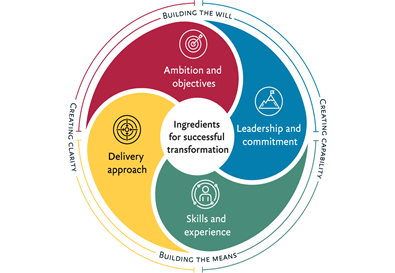Stakeholder management is more than just a box-ticking exercise
We all know that when delivering change across an organisation, we need to involve the people who have a stake in that change. Many of us are likely to have ‘stakeholder management’ in our plans. This typically includes activities such as identifying those people affected and their expected reaction; looking at how best to communicate with them and secure endorsement; managing expectations along the journey; and mitigating the risk of opposition.
However, there is a risk that in focusing on ‘managing’ our stakeholders – where the process may feel like it’s being ‘done to’ them – we miss the benefits of having them truly involved. This can result in poor ownership and poor outcomes.
The key differences between stakeholder management and stakeholder engagement
Perhaps, instead of stakeholder management, we should be thinking about stakeholder engagement? There are a number of key differences between the two approaches.
Co-developing ideas with stakeholders, not just communicating them
Firstly, stakeholder engagement involves working closely with the relevant individuals from the very outset of the initiative to co-develop ideas and solutions, rather than communicating ideas that have been pre-determined by the project team. You should consider the broad set of individuals and interest groups within the organisation to achieve this.
Collective rather than individual working
Secondly, bringing individuals and groups together collectively, rather than picking them off one by one, can create richer conversation, highlighting issues that may otherwise not be covered or benefits that may not have been identified.
Stakeholder engagement provides a tailored approach
Thirdly, by simply changing the emphasis from ‘management’ to ‘engagement’, you are more likely to focus on what different people need to feel truly involved, encouraging a more thoughtful and personalised approach.
True engagement of stakeholders can lead to the development of more successful, innovative solutions that have broader and stronger ownership, as well as better appreciation of why the change is needed. The solutions are more likely to be adopted and may well last longer.
Fostering trust
This approach tends to be used when delivering change in the public sector. For example, the NHS has a complex and assorted set of stakeholders, including local councils, clinicians and professionals from different organisations and sectors, patients, policy makers and the general public. It is critically important (and in some cases legally required) that the diverse groups are engaged from the beginning to highlight challenges and jointly develop solutions. This is a crucial way of ensuring that all parties adopt the changes being delivered.
This is equally applicable to the private sector. For example, when a major UK bank acquired a well-known building society, the intention was to subsume the brand from day one. However, following a series of focus groups with customers, the bank amended its plans, kept the brand and prevented the large predicted number of customers from switching their business to an alternative bank or building society.
Preparing for the challenges
So why is this relevant to your business? Organisations are becoming more aware of the environment in which they operate and the impact it has on them. There are greater expectations to demonstrate corporate social responsibility, and the increasing demand for transparency makes organisations more accountable to the public. More people have an opinion and want a say in how an organisation is run.
But the same principles also apply to how we engage people internally.
For the successful delivery of large-scale change, you have to get genuine buy-in and involvement from different parts of the organisation, its functions, and often its regions as well.
So what are the challenges that come with this approach? It can feel more demanding or more uncomfortable; the result may not be what you expected. Stakeholders may be initially cynical, and it requires more time and effort on your part.
Factors to consider when engaging stakeholders include:
- Be bold – think broadly about who you could engage and how bringing different groups together may be of benefit. Don’t be afraid to involve them in identifying the issues and defining the solutions, rather than giving them your view of the answer. Acknowledge that you don’t have the solutions, but want their help to develop them
- Be prepared – ensure you set up productive discussions by understanding perceptions, interests and expectations in advance. Be clear about the intended outcomes when getting people together, and think about innovative formats and locations in which this can be achieved
- Have strong facilitation – manage sessions effectively by resolving conflicts and misunderstandings, adapting the approach as required and encouraging parties to look for solutions that benefit everybody
- Establish a common vision – aim to achieve common agreement on the outputs. For example, try to come to a consensus on mutual objectives, goals, priorities and actions.
- Show you have listened – acting on and responding to what you have heard builds trust and confidence. Keep the stakeholders informed about progress.
Lasting results
So when embarking on significant change, make sure that the emphasis is on active stakeholder engagement rather than just passive management. In doing so you will ensure that you deliver effective, successful and lasting results across the whole of your organisation.











